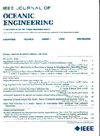使用角速率的全磁力计和陀螺仪偏差估计:基于因子图的方法的理论和实验评估
IF 5.3
2区 工程技术
Q1 ENGINEERING, CIVIL
引用次数: 0
摘要
尽管微机电系统姿态和航向参考系统被广泛用于确定系统姿态,但它们受到传感器测量偏差的限制。本文介绍了一种称为磁力计和陀螺仪校准(MAGYC)的方法,利用角速率陀螺仪的三轴角速率测量来估计磁力计的硬铁和软铁偏差以及陀螺仪的偏差。本文提出了两种基于批量增量因子图和在线增量因子图的实现方法。我们的方法对校准所需的仪器运动施加了较少的限制,消除了对局部磁场大小或仪器姿态的了解的需要,并且便于集成到平滑和映射框架的因子图算法中。通过数值模拟和水下航行器传感器的现场实验验证了所提出的方法。通过在海底测绘潜水的现场数据中实施该方法,水下航行器基于死角的位置估计误差从行进距离的10%降低到0.5%。本文章由计算机程序翻译,如有差异,请以英文原文为准。
Full Magnetometer and Gyroscope Bias Estimation Using Angular Rates: Theory and Experimental Evaluation of a Factor Graph-Based Approach
Despite their widespread use in determining system attitude, micro-electro-mechanical systems attitude and heading reference system are limited by sensor measurement biases. This article introduces a method called Magnetometer and Gyroscope Calibration (MAGYC), leveraging three-axis angular rate measurements from an angular rate gyroscope to estimate both the hard- and soft-iron biases of magnetometers as well as the bias of gyroscopes. We present two implementation methods of this approach based on batch and online incremental factor graphs. Our method imposes fewer restrictions on instrument movements required for calibration, eliminates the need for knowledge of the local magnetic field magnitude or instrument's attitude, and facilitates integration into factor graph algorithms for smoothing and mapping frameworks. We validate the proposed methods through numerical simulations and in-field experimental evaluations with a sensor onboard an underwater vehicle. By implementing the proposed method in field data of a seafloor mapping dive, the dead-reckoned-based position estimation error of the underwater vehicle was reduced from 10% to 0.5% of the distance traveled.
求助全文
通过发布文献求助,成功后即可免费获取论文全文。
去求助
来源期刊

IEEE Journal of Oceanic Engineering
工程技术-工程:大洋
CiteScore
9.60
自引率
12.20%
发文量
86
审稿时长
12 months
期刊介绍:
The IEEE Journal of Oceanic Engineering (ISSN 0364-9059) is the online-only quarterly publication of the IEEE Oceanic Engineering Society (IEEE OES). The scope of the Journal is the field of interest of the IEEE OES, which encompasses all aspects of science, engineering, and technology that address research, development, and operations pertaining to all bodies of water. This includes the creation of new capabilities and technologies from concept design through prototypes, testing, and operational systems to sense, explore, understand, develop, use, and responsibly manage natural resources.
 求助内容:
求助内容: 应助结果提醒方式:
应助结果提醒方式:


